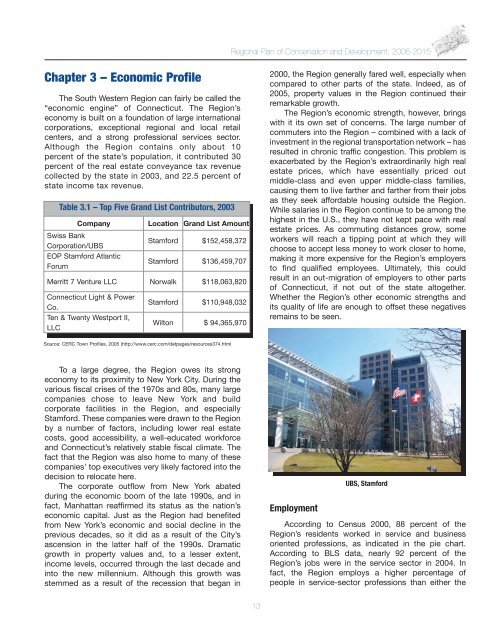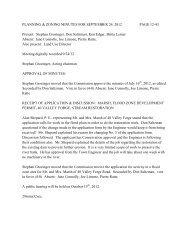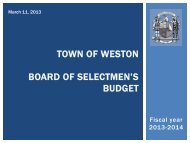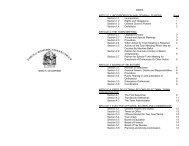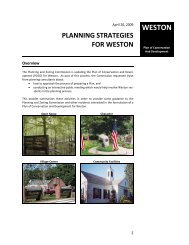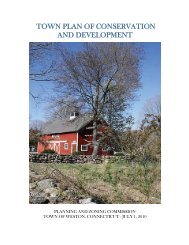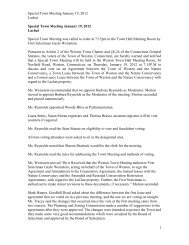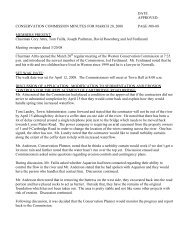Regional Plan of Conservation and Development, 2006-2015
Regional Plan of Conservation and Development, 2006-2015
Regional Plan of Conservation and Development, 2006-2015
Create successful ePaper yourself
Turn your PDF publications into a flip-book with our unique Google optimized e-Paper software.
<strong>Regional</strong> <strong>Plan</strong> <strong>of</strong> <strong>Conservation</strong> <strong>and</strong> <strong>Development</strong>, <strong>2006</strong>-<strong>2015</strong>Chapter 3 – Economic Pr<strong>of</strong>ileThe South Western Region can fairly be called the“economic engine” <strong>of</strong> Connecticut. The Region’seconomy is built on a foundation <strong>of</strong> large internationalcorporations, exceptional regional <strong>and</strong> local retailcenters, <strong>and</strong> a strong pr<strong>of</strong>essional services sector.Although the Region contains only about 10percent <strong>of</strong> the state’s population, it contributed 30percent <strong>of</strong> the real estate conveyance tax revenuecollected by the state in 2003, <strong>and</strong> 22.5 percent <strong>of</strong>state income tax revenue.Table 3.1 – Top Five Gr<strong>and</strong> List Contributors, 2003CompanySwiss BankCorporation/UBSEOP Stamford AtlanticForumLocation Gr<strong>and</strong> List AmountStamford $152,458,372Stamford $136,459,707Merritt 7 Venture LLC Norwalk $118,063,820Connecticut Light & PowerCo.Ten & Twenty Westport II,LLCStamford $110,948,032Wilton $ 94,365,9702000, the Region generally fared well, especially whencompared to other parts <strong>of</strong> the state. Indeed, as <strong>of</strong>2005, property values in the Region continued theirremarkable growth.The Region’s economic strength, however, bringswith it its own set <strong>of</strong> concerns. The large number <strong>of</strong>commuters into the Region – combined with a lack <strong>of</strong>investment in the regional transportation network – hasresulted in chronic traffic congestion. This problem isexacerbated by the Region’s extraordinarily high realestate prices, which have essentially priced outmiddle-class <strong>and</strong> even upper middle-class families,causing them to live farther <strong>and</strong> farther from their jobsas they seek affordable housing outside the Region.While salaries in the Region continue to be among thehighest in the U.S., they have not kept pace with realestate prices. As commuting distances grow, someworkers will reach a tipping point at which they willchoose to accept less money to work closer to home,making it more expensive for the Region’s employersto find qualified employees. Ultimately, this couldresult in an out-migration <strong>of</strong> employers to other parts<strong>of</strong> Connecticut, if not out <strong>of</strong> the state altogether.Whether the Region’s other economic strengths <strong>and</strong>its quality <strong>of</strong> life are enough to <strong>of</strong>fset these negativesremains to be seen.Source: CERC Town Pr<strong>of</strong>iles, 2005 (http://www.cerc.com/detpages/resources374.htmlTo a large degree, the Region owes its strongeconomy to its proximity to New York City. During thevarious fiscal crises <strong>of</strong> the 1970s <strong>and</strong> 80s, many largecompanies chose to leave New York <strong>and</strong> buildcorporate facilities in the Region, <strong>and</strong> especiallyStamford. These companies were drawn to the Regionby a number <strong>of</strong> factors, including lower real estatecosts, good accessibility, a well-educated workforce<strong>and</strong> Connecticut’s relatively stable fiscal climate. Thefact that the Region was also home to many <strong>of</strong> thesecompanies’ top executives very likely factored into thedecision to relocate here.The corporate outflow from New York abatedduring the economic boom <strong>of</strong> the late 1990s, <strong>and</strong> infact, Manhattan reaffirmed its status as the nation’seconomic capital. Just as the Region had benefitedfrom New York’s economic <strong>and</strong> social decline in theprevious decades, so it did as a result <strong>of</strong> the City’sascension in the latter half <strong>of</strong> the 1990s. Dramaticgrowth in property values <strong>and</strong>, to a lesser extent,income levels, occurred through the last decade <strong>and</strong>into the new millennium. Although this growth wasstemmed as a result <strong>of</strong> the recession that began inEmploymentUBS, StamfordAccording to Census 2000, 88 percent <strong>of</strong> theRegion’s residents worked in service <strong>and</strong> businessoriented pr<strong>of</strong>essions, as indicated in the pie chart.According to BLS data, nearly 92 percent <strong>of</strong> theRegion’s jobs were in the service sector in 2004. Infact, the Region employs a higher percentage <strong>of</strong>people in service-sector pr<strong>of</strong>essions than either the13


